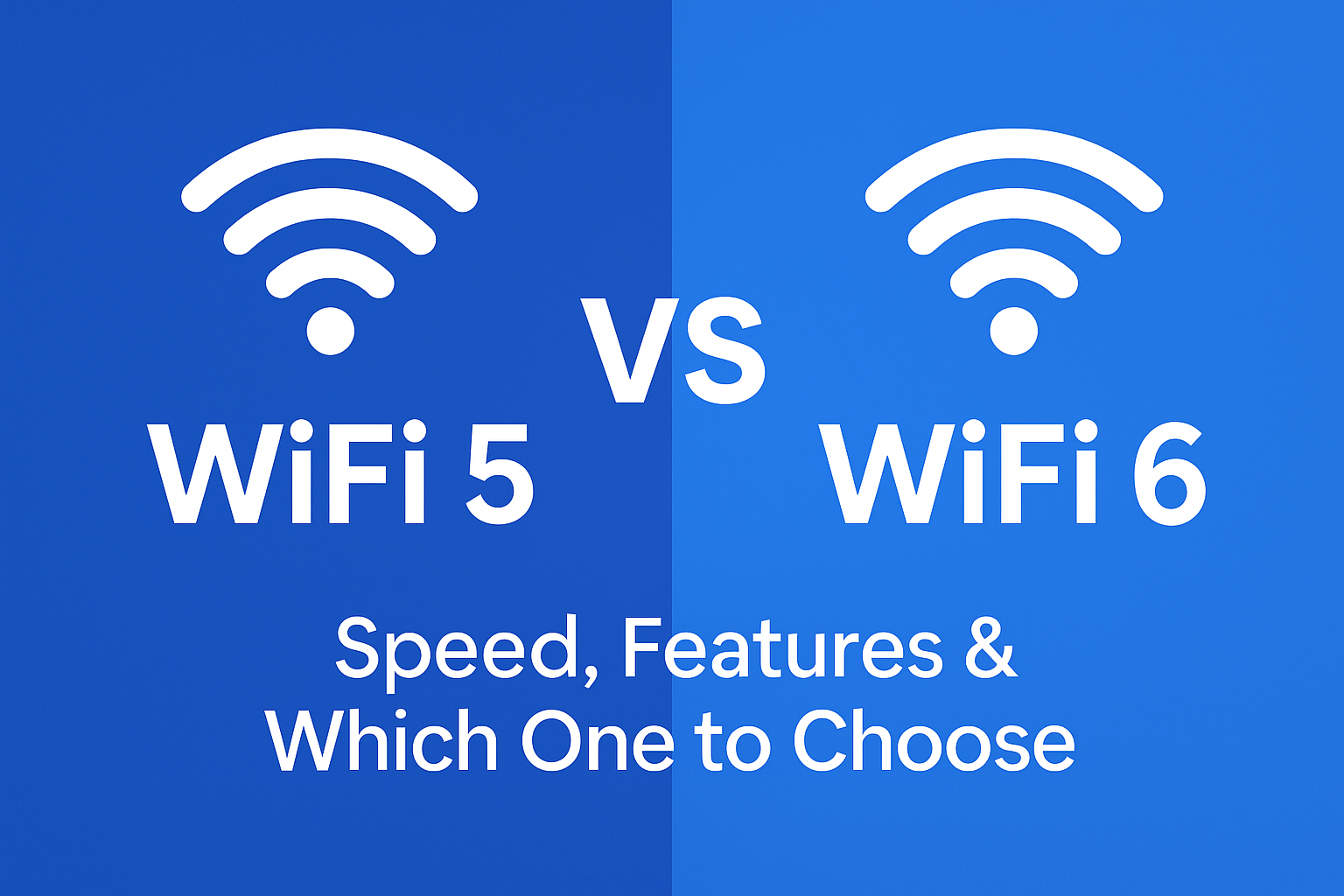Introduction
Internet speed and reliability have become essential in modern life. Whether you’re streaming movies, attending virtual meetings, or running a smart home, your WiFi plays a central role.
Two common wireless standards dominate the market: WiFi 5 (802.11ac) and WiFi 6 (802.11ax). If you’re shopping for a new router, laptop, or smartphone, you’ve probably seen these terms—but what do they mean, and does upgrading to WiFi 6 really make a difference?
This guide will break down the differences between WiFi 5 and WiFi 6, including speed, coverage, device handling, and efficiency, so you can decide whether an upgrade is worth it.
What Is WiFi 5 (802.11ac)?
WiFi 5, also known as 802.11ac, launched in 2014. It quickly became the mainstream standard, replacing WiFi 4 (802.11n).
Key Features of WiFi 5:
- Operates primarily on the 5 GHz band (faster but shorter range).
- Theoretical speeds up to 3.5 Gbps.
- Supports MU-MIMO (multi-user multiple-input multiple-output) for simultaneous connections.
- Great for streaming, online gaming, and general browsing.
WiFi 5 was revolutionary for its time, but with more connected devices in households today, it shows limitations.
What Is WiFi 6 (802.11ax)?
WiFi 6, also known as 802.11ax, was released in 2019. It was designed to improve efficiency, speed, and capacity in increasingly crowded networks.
Key Features of WiFi 6:
- Works on both 2.4 GHz and 5 GHz bands (with WiFi 6E adding 6 GHz).
- Theoretical speeds up to 9.6 Gbps.
- Uses OFDMA (Orthogonal Frequency Division Multiple Access) to split channels into smaller sub-channels for better efficiency.
- Enhanced MU-MIMO for more devices at once.
- Target Wake Time (TWT) improves battery life for mobile and IoT devices.
WiFi 6 is built for the future—homes with smart TVs, security cameras, IoT devices, and multiple simultaneous video calls.
WiFi 5 vs WiFi 6: Side-by-Side Comparison
| Feature | WiFi 5 (802.11ac) | WiFi 6 (802.11ax) |
|---|---|---|
| Release Year | 2014 | 2019 |
| Max Speed | ~3.5 Gbps | ~9.6 Gbps |
| Frequency Bands | 5 GHz | 2.4 GHz + 5 GHz (6 GHz with WiFi 6E) |
| Device Handling | Limited | Handles more devices efficiently |
| MU-MIMO | Yes (downlink only) | Yes (uplink + downlink) |
| OFDMA | No | Yes, for efficiency |
| Battery Optimization | No | Yes (Target Wake Time) |
| Best For | General home use | Smart homes, 4K/8K streaming, gaming, multiple devices |
WiFi 5 vs WiFi 6 Speeds in Real Life
It’s easy to look at theoretical numbers, but real-world performance is more telling.
- WiFi 5: Real-world speeds usually hover between 300 Mbps and 1 Gbps depending on your router and ISP.
- WiFi 6: Can reach 1–2 Gbps in practical scenarios, especially on high-speed internet plans (>500 Mbps).
👉 If your internet plan is under 200 Mbps, WiFi 6 won’t feel drastically faster. But if you’re on gigabit internet, WiFi 6 can help you get the most out of your plan.
WiFi 6 and Device Capacity
One of the biggest upgrades in WiFi 6 is its ability to handle many devices simultaneously.
- WiFi 5 networks start struggling when 10+ devices are connected (video calls lag, games stutter).
- WiFi 6 can efficiently manage dozens of devices thanks to OFDMA and better MU-MIMO.
This makes WiFi 6 ideal for:
- Smart homes with IoT devices.
- Families with multiple gamers, streamers, and workers.
- Offices and co-working spaces.
WiFi 5 vs WiFi 6: Coverage and Range
- WiFi 5 (5 GHz only): Faster but weaker at long distances or through walls.
- WiFi 6 (2.4 + 5 GHz): Stronger coverage thanks to 2.4 GHz band support.
If you live in a large house, WiFi 6 will generally perform better, especially with mesh router setups.
Security: WPA3 in WiFi 6
WiFi 6 also introduced WPA3 encryption, which provides stronger protection against hacking. WiFi 5 routers typically only support WPA2.
For anyone concerned with network security, WiFi 6 is the safer option.
Should You Upgrade from WiFi 5 to WiFi 6?
Upgrade if:
- You have gigabit internet plans.
- You own many smart devices.
- You want better coverage in a large home.
- You value security upgrades (WPA3).
Stick with WiFi 5 if:
- Your plan is under 200 Mbps.
- You don’t have many connected devices.
- You want a budget-friendly router.
FAQs
1. Does WiFi 6 require a new router?
Yes. To use WiFi 6, you need a WiFi 6-enabled router.
2. Will my old devices work with WiFi 6?
Yes, WiFi 6 routers are backward compatible with WiFi 5 devices.
3. Is WiFi 6 worth it for gaming?
Absolutely. WiFi 6 offers lower latency and better stability in multiplayer gaming.
4. What about WiFi 6E?
WiFi 6E adds the 6 GHz band, offering even faster speeds and less congestion. However, it requires compatible devices.
Conclusion
WiFi 6 is not just about faster speeds—it’s about efficiency, device handling, and security. While WiFi 5 still works well for small households, WiFi 6 is the smarter choice for modern, connected lifestyles.
If you’re upgrading your router in 2025, going for WiFi 6 (or 6E) will future-proof your home or office network.


Leave a Reply